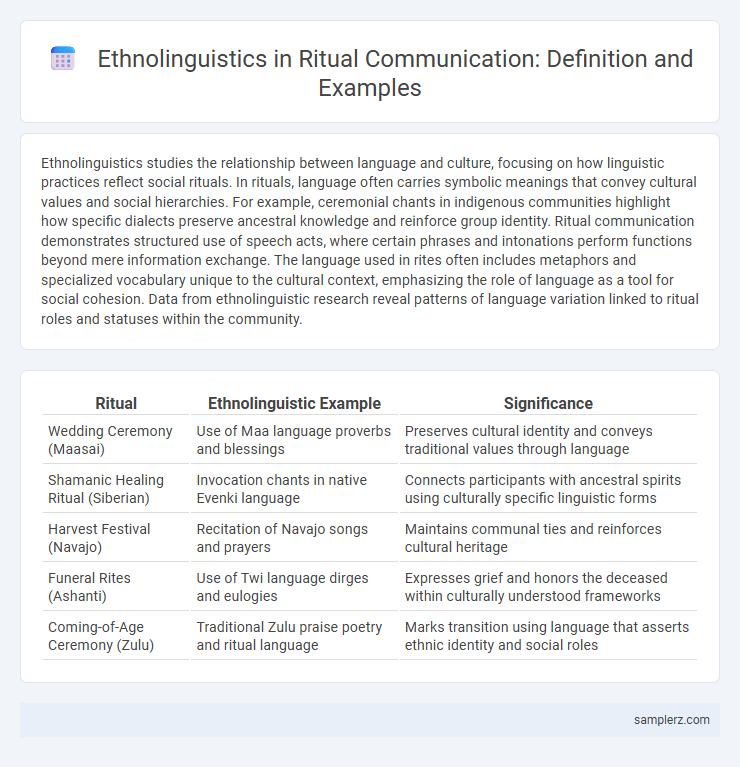Ethnolinguistics studies the relationship between language and culture, focusing on how linguistic practices reflect social rituals. In rituals, language often carries symbolic meanings that convey cultural values and social hierarchies. For example, ceremonial chants in indigenous communities highlight how specific dialects preserve ancestral knowledge and reinforce group identity. Ritual communication demonstrates structured use of speech acts, where certain phrases and intonations perform functions beyond mere information exchange. The language used in rites often includes metaphors and specialized vocabulary unique to the cultural context, emphasizing the role of language as a tool for social cohesion. Data from ethnolinguistic research reveal patterns of language variation linked to ritual roles and statuses within the community.
Table of Comparison
| Ritual | Ethnolinguistic Example | Significance |
|---|---|---|
| Wedding Ceremony (Maasai) | Use of Maa language proverbs and blessings | Preserves cultural identity and conveys traditional values through language |
| Shamanic Healing Ritual (Siberian) | Invocation chants in native Evenki language | Connects participants with ancestral spirits using culturally specific linguistic forms |
| Harvest Festival (Navajo) | Recitation of Navajo songs and prayers | Maintains communal ties and reinforces cultural heritage |
| Funeral Rites (Ashanti) | Use of Twi language dirges and eulogies | Expresses grief and honors the deceased within culturally understood frameworks |
| Coming-of-Age Ceremony (Zulu) | Traditional Zulu praise poetry and ritual language | Marks transition using language that asserts ethnic identity and social roles |
Exploring Ethnolinguistics: Ritual Language Across Cultures
Ritual language across cultures reveals deep connections between language, belief systems, and social identity, exemplified by the use of sacred chants in Hindu pujas and the complex invocation formulas of Indigenous Australian ceremonies. Ethnolinguistics examines how these specialized linguistic forms encode cultural values, reinforce community bonds, and facilitate spiritual experiences unique to each group. Understanding ritual language offers insight into the symbolic power of speech acts and the transmission of cultural knowledge.
Symbolic Communication: The Role of Language in Rituals
In rituals, language functions as a powerful symbolic communication tool that conveys cultural values and social norms inherent in ethnolinguistics. Specific words, phrases, and chants often hold sacred meanings that transcend their literal interpretation, reinforcing group identity and continuity. These linguistic elements facilitate shared understanding and emotional resonance, underscoring the integral role of language in ritualistic practices across diverse cultures.
Sacred Words: Ethnolinguistic Practices in Religious Ceremonies
Sacred words in religious ceremonies serve as powerful ethnolinguistic markers that reinforce cultural identity and spiritual beliefs. These ritual utterances, often preserved in ancient or liturgical languages such as Sanskrit, Latin, or Arabic, encapsulate theological concepts and communal values unique to specific religious groups. Analyzing sacred language use reveals how linguistic structures and semantic fields shape and sustain religious experiences within ethnolinguistic communities.
Chanting and Incantations: Linguistic Patterns in Ritual Acts
Chanting and incantations in ritual acts reveal distinct ethnolinguistic patterns that reflect cultural values and spiritual beliefs of specific communities. These linguistic elements utilize repetitive phonetic structures and rhythmical phrasing to enhance mnemonic retention and create a cognitive link between language and sacred meaning. Analyzing these patterns provides insight into how language functions as a powerful medium for ritual communication and identity reinforcement.
Code-Switching and Identity in Ritual Contexts
Code-switching in ritual contexts serves as a powerful expression of identity, allowing participants to navigate between languages to convey social roles, spiritual authority, and cultural belonging. Ethnolinguistic analysis reveals how shifts between languages during ceremonies reinforce group cohesion and signal respect for ancestral traditions. Rituals embed linguistic choices with symbolic meaning, making code-switching a key mechanism for preserving and negotiating ethnic identity.
Oral Traditions: Preserving Ritual Language Through Generations
Oral traditions serve as a vital ethnolinguistic tool for preserving ritual language across generations, encapsulating cultural values and sacred meanings within spoken narratives. Storytelling, chants, and ceremonial speeches maintain linguistic nuances unique to ritual contexts, ensuring the continuity of communal identity and spiritual heritage. This transmission method strengthens intergenerational bonds and reinforces the cultural framework integral to ritual practice.
Speech Acts: Performing Ritual through Language
In ethnolinguistics, speech acts play a crucial role in performing rituals by conveying shared cultural meanings and social intentions within a community. For example, the ritual of a wedding ceremony often involves performative utterances such as "I now pronounce you husband and wife," which enact a social transformation through language. These speech acts not only fulfill ceremonial functions but also reinforce collective identity and cultural values embedded in the ritual context.
Language, Taboo, and Power in Ritual Communication
Ethnolinguistics in ritual communication reveals how language shapes power dynamics and enforces social norms through taboo expressions. Certain words or phrases are deliberately avoided or restricted during rituals to maintain sacredness and authority, reflecting cultural values and hierarchical structures. These linguistic taboos function as mechanisms of control, reinforcing the power of ritual leaders and preserving communal identity.
Ritual Greetings and Farewells: Ethnolinguistic Significance
Ritual greetings and farewells serve as key examples of ethnolinguistics, highlighting how language use reflects cultural values and social hierarchies within rituals. These speech acts often involve culturally specific phrases, gestures, and intonations that reinforce group identity and social cohesion. Understanding the ethnolinguistic significance of ritual greetings and farewells provides insight into the symbolic meanings embedded in communicative practices across diverse cultural contexts.
Linguistic Innovation: Evolving Language in Modern Rituals
Linguistic innovation in modern rituals reflects dynamic changes in ethnolinguistics by incorporating new vernacular and symbolic expressions that resonate with contemporary cultural identities. For instance, digital communication platforms foster novel ritualistic language forms, blending traditional phrases with internet slang to create unique ceremonial vocabularies. These evolving linguistic patterns demonstrate how communities adapt ritual narratives to maintain relevance and reinforce social cohesion in rapidly changing environments.

example of ethnolinguistics in ritual Infographic
 samplerz.com
samplerz.com